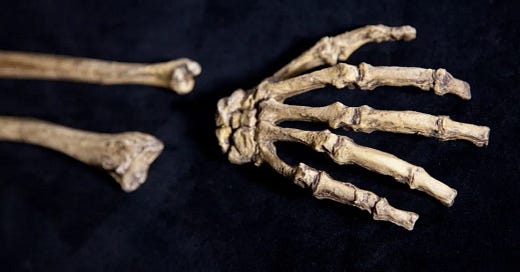Ancient Origins of Tool Use: Australopithecine Hands Suggest Early Manipulation Abilities
New research into australopithecine hand anatomy suggests that dexterity and tool use may have predated the rise of Homo, challenging long-standing views on early human evolution.
Uncovering Tool Use in Early Hominins
A recent study1 into the hand bones of Australopithecus afarensis — the species that includes the famous "Lucy" — suggests that early hominins may have been adept at using tools more than 3 million years ago. Researchers from the University of Tübingen have found that australopithecine hands exhibited the necessary muscle attachments for complex object manipulation. These findings offer new insights into the evolutionary pathways of dexterity and cultural development that began long before the genus Homo emerged.
"While we can't definitively say that these early humans crafted stone tools, our findings demonstrate that their hands were frequently used in ways that closely align with the actions necessary for human tool manipulation," explained Fotios Alexandros Karakostis, a paleoanthropologist at the University of Tübingen.
Exploring Muscle Attachment Sites for Clues
The study, published in Journal of Human Evolution, examined the "hand entheses"—muscle attachment sites where tendons anchor muscles to bones—across three australopithecine species, as well as in apes and modern humans. These attachment sites adapt and strengthen with frequent use, allowing researchers to infer habitual behaviors.
"By studying these muscle attachment sites, we can reconstruct how muscles and ligaments were actively engaged throughout life, giving us a clearer picture of early hominin behavior," Karakostis added.
The analysis revealed that australopithecines like A. afarensis, A. africanus, and A. sediba likely engaged in dexterous behaviors. However, the younger A. sediba hand displayed more human-like traits compared to the mosaic of apelike and humanlike features found in the hands of A. afarensis and A. africanus, which lived 3.7 to 3 million years ago. These findings point to a progressive evolution of dexterity and fine motor skills within early hominins.

The Role of the Pinky in Early Tool Use
The researchers observed that the pinky finger played a significant role in grasping, particularly in early hominins like A. afarensis and A. sediba. This feature likely supported essential daily activities, such as food preparation and handling objects, suggesting that these species may have used simple tools.
"More broadly speaking, the co-evolution of the thumb and pinky were decisive for hominin biocultural evolution, setting the stage for the advanced humanlike dexterity we see in humans today," commented Jana Kunze, the study's first author.
Rethinking Tool Use in Australopithecines
The question of which species first made and used tools is a longstanding debate in paleoanthropology. When Homo habilis, known as "handyman," was discovered alongside stone tools from 2.3 million years ago, it was widely assumed that australopithecines lacked the mental or physical capabilities for toolmaking. However, the 2015 discovery of 3.3 million-year-old tools at Lomekwi in Kenya has challenged this view, raising the possibility that A. afarensis may have been capable of making and using tools.
"Our study indicates that Australopithecus afarensis — the species Lucy belonged to — frequently performed humanlike grasping patterns, using their hands in ways that suggest regular, skilled manipulation of objects within the hand," stated Karakostis. He added, "These findings don't directly show that A. afarensis or A. sediba made or used stone tools in particular."
Unique Dexterity in Early Hominins
Despite their impressive manipulation abilities, apes lack certain anatomical features essential for precision grips, which limits their dexterity compared to early hominins. Modern humans, by contrast, possess two key muscles: the flexor pollicis longus, which enhances thumb strength, and the first dorsal interosseous muscle, located between the thumb and index finger, allowing for a precise pinch grip.
"This unique functionality provided early hominins with the dexterity needed to manipulate objects — including tools — effectively, paving the way for both technological and cultural progress," noted Kunze.
Broader Implications for Human Evolution
These findings point to a complex timeline of dexterity evolution in early hominins. Australopithecus afarensis and A. sediba displayed substantial manipulation abilities, which, while not necessarily linked directly to stone tools, could indicate broader cultural behaviors. Tracy Kivell, director of Human Origins at the Max Planck Institute for Evolutionary Anthropology, noted that this research enriches our understanding of early human-environment interactions.
"It is likely that each of these australopiths were using tools and climbing," Kivell observed. "The muscle attachment sites provide exciting information about how these particular australopith individuals were using their hands during life."
Ultimately, this research pushes back the timeline of dexterous capabilities among early hominins and hints that the cognitive and physical adaptations for tool use may have developed far earlier than previously believed. As investigations continue, studies like this one are poised to reshape our understanding of early human behavior, potentially rewriting the story of our ancestors' journey toward cultural complexity and technological innovation.
Kunze, J., Harvati, K., Hotz, G., & Karakostis, F. A. (2024). Humanlike manual activities in Australopithecus. Journal of Human Evolution, 196(103591), 103591. https://doi.org/10.1016/j.jhevol.2024.103591


